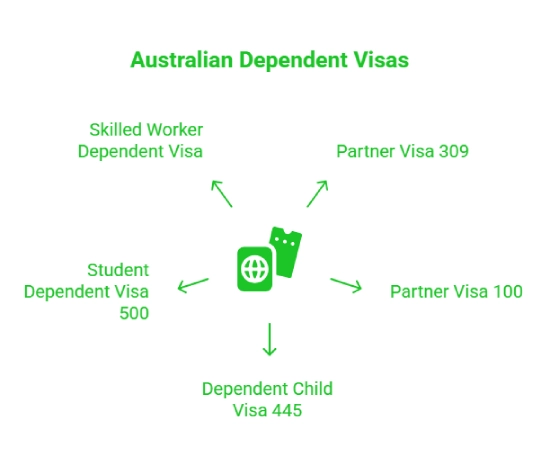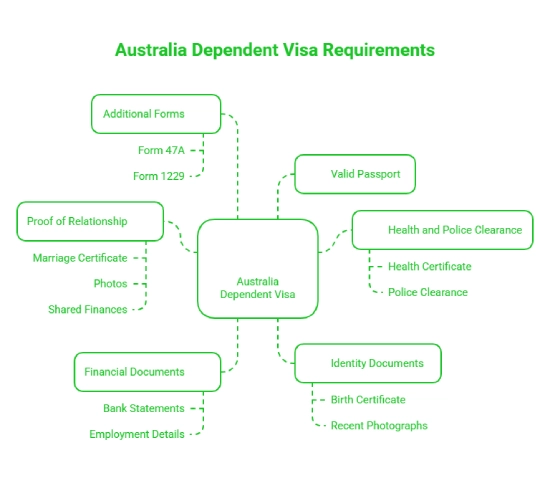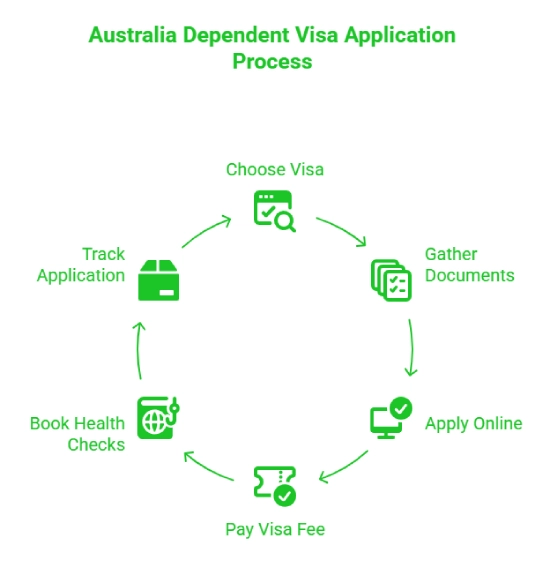If you are living in Canada and have a spouse, partner, or child in Australia or someone planning to move there, you might be eligible to join them through an Australia Dependent Visa. This visa helps bring families together, giving you the chance to live, study, and even work in Australia while staying close to your loved ones.

An Australia Dependent Visa allows immediate family members of Australian citizens, permanent residents, or eligible New Zealand citizens to live in Australia. Whether you're a spouse, partner, or dependent child, this visa is your way to join your family and build a life in Australia. If you're currently in Canada, you can apply online through the ImmiAccount portal, the official platform of the Australian Department of Home Affairs.
*Want to apply for an Australian Dependent Visa? Sign up with Y-Axis to help you with the process.
A temporary visa for those married to or in a committed relationship with an Australian citizen or permanent resident. It’s the first step toward permanent residency.
This is the permanent visa that follows the 309, allowing you to stay in Australia indefinitely with your partner.
Designed for children of parents who are holding a temporary Partner visa and waiting for their permanent status.
If your spouse or parent is studying in Australia, you can apply as a dependent. In most cases, spouses can work part-time during the course.
For dependents of skilled workers living in Australia. You’ll have full rights to live, study, and work for the duration of the primary visa.

To apply for a dependent visa, you'll need:

Step 1: Choose the right visa
Pick the visa subclass that matches your relationship and your sponsor’s visa type.
Step 2: Gather documents
Collect everything you need—proof of relationship, financials, health records, and ID.
Step 3: Apply online
Create an account on the ImmiAccount portal and submit your application.
Step 4: Pay the visa fee
Fees depend on the type of visa you're applying for.
Step 5: Book health checks and biometrics
You may be asked to visit a local visa centre (AVAC) in Canada for biometrics and health screenings.
Step 6: Track your application
Use ImmiAccount to stay updated and wait for the decision via email.

Fees are subject to change. Additional charges may apply for health exams, police clearances, or biometrics.
| Visa Type | Base Fee (AUD) |
| Partner Visa (Subclass 309/100) | AUD 8,850 |
| Dependent Child Visa (Subclass 445) | AUD 2,790 |
| Student Dependent Visa (Subclass 500) | AUD 650 – AUD 2,500 |
| Skilled Dependent Visa (482/186) | Varies by occupation |
Processing times vary based on your documents, the visa type, and application volume. Apply early to avoid delays.
| Visa Type | Estimated Time |
| Partner (Subclass 309) | 11–18 months |
| Partner (Subclass 100) | 17–23 months |
| Dependent Child (Subclass 445) | 8–12 months |
| Student Dependent (Subclass 500) | 3–5 months |
| Skilled Dependent (Subclass 482) | 1–3 months |
Yes. If you’re a Canadian permanent resident, especially someone holding an Indian or other non-Canadian passport, you can apply for an Australia Dependent Visa from within Canada. You’ll need to provide proof of your Canadian residency and go through the online application process via ImmiAccount. Health checks and biometrics will be scheduled at a Visa Application Centre (AVAC) near you in Canada.
At Y-Axis, we make your Australia Dependent Visa journey easier with end-to-end support:
A dependent visa in Australia allows close family members, like spouses, de facto partners, and dependent children, etc. to join a visa holder or sponsor already living in Australia. It is available under various visa subclasses, including student, skilled worker, and partner visas. These visas let dependents live, and often study or work, depending on their specific visa conditions. If you're in Canada and want to join a family member in Australia, you can apply online through ImmiAccount, the official platform for Australian visa applications.
Yes, many dependent visa holders in Australia have work rights, though conditions vary by visa type. Spouses of skilled workers and permanent residents typically have full-time work rights. If you are a dependent of an international student, work limits apply usually 40 hours per fortnight during term time. Partner visa applicants may also work while waiting for permanent status. Work rights are clearly outlined in your visa grant letter, so it's essential to review your conditions upon approval.
Yes, spouses on dependent visas in Australia can usually work, but the level of work rights depends on the primary visa holder’s status. Spouses of skilled workers or permanent residents are often allowed to work full-time. Those accompanying student visa holders (Subclass 500) may work 40 hours per fortnight, unless the student is pursuing a master’s or PhD, in which case full-time work is permitted. Always refer to your visa grant notification for exact details, as conditions vary across visa subclasses.
A spouse can apply for a dependent visa by linking their application to the main applicant’s visa, such as a Partner Visa (Subclass 309/100), Student Visa (Subclass 500), or Skilled Visa (Subclass 482 or 186). You must create an account on ImmiAccount, complete the relevant form, upload required documents (proof of marriage, identity, financials, and police checks), and pay the applicable fee. Canadian residents can apply online and attend biometrics and medical appointments in Canada before the visa decision.
Yes, international students in Australia can bring their spouse and dependent children on a Student Dependent Visa under Subclass 500. The main applicant must provide evidence of enrolment (CoE), financial capacity, and health insurance for all dependents. Spouses may work up to 40 hours per fortnight, unless the student is pursuing a postgraduate research degree, in which case full-time work is allowed. Children must be enrolled in school. Applications can be submitted online through the ImmiAccount portal.
Parents are not eligible under the general dependent visa category in Australia. However, there are specific parent visa options, such as the Contributory Parent Visa (Subclass 143) and the Sponsored Parent (Temporary) Visa (Subclass 870). These visas allow eligible children (usually Australian citizens or permanent residents) to sponsor their parents for temporary or permanent residence. These visas have strict eligibility criteria, high fees, and long processing times, but they provide a legal pathway for parents to stay in Australia.
For most Australian dependent visas, children must be under 18 years of age. However, children aged 18 to 23 may still qualify if they are financially dependent on the primary visa holder and not married or in a de facto relationship. Children with a recognized disability may be eligible regardless of age. There’s no age limit for spouses or partners, but the relationship must be genuine and ongoing. Always check the eligibility criteria based on the specific visa subclass.
To apply for a dependent visa from Canada:
Step 1: First determine which visa subclass you qualify for based on your relationship and the sponsor’s status.
Step 2: Visit the official website, register, and complete the online application.
Step 3: Upload documents like your passport, relationship proof, health insurance, and financials.
Step 4: Pay the visa fee and attend biometrics and medical exams in Canada if required.
Step 5: You can track your application online and receive updates via email.
The cost of an Australian dependent visa depends on the subclass:
Note: These are base fees only, while additional costs may include health exams, police clearances, and biometric fees. Fees must be paid in Australian dollars and are non-refundable, even if the visa is refused.
Documents for an Australia dependent visa typically include:
Note: All documents should be in English or include certified translations.